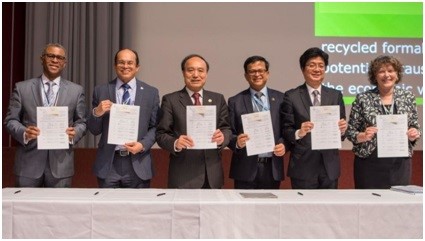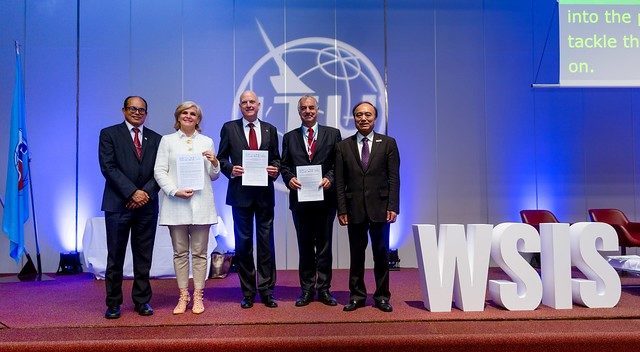Inter-agency Group on Tackling E-waste

The Challenge
E-waste is one of the fastest growing waste streams in developed as well as developing countries. The decreasing life-span of products such as computers and mobile phones has reduced significantly in developed countries, subsequently increasing the amount of e-waste generated per year.
This has a major impact on developing countries because much of this hazardous material is exported from developed to developing countries. Rudimentary methods like open burning, which are widely used by the informal sector in developing countries to recover valuable materials, have heavy impacts on the environment and human health.
Key figures
o In 2016, 44.7 million metric tonnes of e-waste were generated, of which only 20% was collected and recycled
o By 2050, the volume of e-waste could top 120 million tonnes annually
o The estimated value of raw materials in e-waste stands at roughly 55 billion euros, which is more than the GDP of most countries in the world
o The United Nations has engaged in over 150 projects, publications, reports and programmes since the year 2004
As a response to the global e-waste challenge, an increasing number of initiatives from international actors have been established, including work by the United Nations.
The EMG’s Issue Management Group on Tackling E-waste published the report United Nation’s System-wide Response to Tackling E-waste (2017), highlighted the need for strengthened collaboration among United Nations organisations, with over 20 organisations active in tackling e-waste and over 150 e-waste initiatives having been undertaken since 2004. The report offers recommendations on maximizing system-wide coherence towards a life-cycle approach to tackling e-waste.
The E-waste Coalition
In March 2018, a non-binding Letter of Intent was signed by seven organisations from the United Nations system, active in addressing the global e-waste challenge. This Letter serves as a basis for coordination and collaboration on United Nations system-wide support for e-waste management and the creation of an E-waste Coalition. In April 2019, three more UN agencies joined the Coalition by signing the Letter of Intent.


Signatories include the International Telecommunications Union, United Nations University, United Nations Industrial Development Organization, United Nations Environment Programme, the Secretariat of the Basel, Rotterdam and Stockholm, Conventions, International Labour Organization, United Nations Human Settlements Programme, International Trade Centre, United Nations Institute for Training and Research, and the World Health Organization.

The E-waste Coalition is currently being shaped in line with the Letter’s aims of committing to increased collaboration, building partnerships and supporting Member States to address the global e-waste challenge.
Three core functions of the Coalition are envisaged: advocacy including awareness raising and campaigns; knowledge and best practice sharing including through the website globalewaste.org; and the development of a joint intervention model for the implementation of e-waste work at the country level.



The E-waste Coalition Concept Note is a living document, developed as the E-waste Coalition vision and mission, governance structure, membership and core functions are conceptualized.
New Circular Vision for Electronics
Addressing the e-waste challenge requires collaboration among a multitude of stakeholders across the life-cycle of electrical and electronic equipment. The signatories of the Letter of Intent are working with entities such as the World Economic Forum and the World Business Council for Sustainable Development to encourage a circular economy for electrical and electronic equipment.
The report A New Circular Vision for Electronics – Time for a Global Reboot was released at the World Economic Forum’s annual meeting in Davos in January 2019 as a collaboration between the E-waste Coalition, the World Economic Forum and the World Business Council for Sustainable Development. The report compiles data and research from throughout the UN system to make the case for a new vision and describes and analyses challenges and opportunities, laying the groundwork for the process of systemic change. Collaboration continues to further develop this new vision with the purpose to align all the relevant United Nations entities, key governments and some of the largest electronics multinationals around a common plan for the future of the electronics sector based on the principles of the circular economy.
To find out more or to become involved, please contact the EMG Secretariat at [email protected].
Related links and Resources:
- UN System-wide Response to Tackling E-Waste (Summary)
- PACE Report: A New Circular Vision for Electronics
- UN Environment News: The E-Waste Letter of Intent
- WRF News: the E-Waste Coalition
- ITU News: the 2019 WSIS Forum High Level Dialogue, Building an E-Waste Coalition.
- The Global E-Waste Statistics Partnership– monitoring developments related to e-waste and helping countries produce e-waste statistics.
- The Global E-Waste Monitor– a comprehensive report on global e-waste statistics.